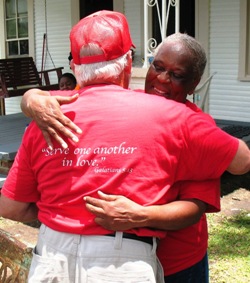“Carry each other’s burdens, and in this way you will fulfill the law of Christ.” (Gal. 6:2 NIV)
Challenged by this Biblical mandate to “carry each other’s burdens,” the Church of the Brethren traditionally has been involved in the relief of suffering, whether caused by war, strife or natural disaster. Formerly known as Brethren Disaster Services, the program was originally part of the Brethren Service Commission, which was established in 1941.

The myrtle wood service cup was adopted in 1942 as a symbol for Brethren Service at the Asheville, N.C. Annual Conference. The logo, designed by Annette Mowe, symbolizes reconciliation as the Germantown communion cup is being passed from one person to another.
The Emergency Disaster Fund was established in 1960 support all Brethren disaster recovery projects and relief efforts. These efforts were somewhat sporadic and small-scale until a massive disaster struck in 1972.
Devastating floods from Hurricane Agnes in 1972 inundated the tri-state region of Maryland, Pennsylvania and Virginia. Brethren Disaster Services responded with 2,203 volunteers who assisted 725 of the affected households in Wilkes-Barre, Penna. The severity of this disaster compelled the 1973 Annual Conference to establish disaster response guidelines as part of the goals for the decade, as well as a formal disaster response network within the districts.
This action brought the dawning of a new era for the disaster response ministry of the Church of the Brethren. The disaster response guidelines provided the basis for the church’s response in the aftermath of a disaster, and the disaster response network provided an organized vehicle for the recruitment of volunteers to aid disaster-stricken communities. The guidelines were expanded in 1979 with the founding of Children’s Disaster Services (formerly Disaster Child Care).
At first, the responsibility of carrying out the disaster response guidelines was shared among three managers at the Brethren Service Center in New Windsor, Md. These three were D. Miller Davis, Kenneth McDowell, and Mac Coffman. Several years later, approval was given for the creation of the General Board staff position of Director of Disaster Response and Refugee Resettlement. R. Jan Thompson was hired in 1978 as the first person to fill this position. The Disaster Response Program as it was formerly called was born, and the disaster response network could now be further developed and strengthened.
Each Church of the Brethren district has an appointed disaster coordinator who issues district-wide appeals for volunteers when they are needed for specific disaster response projects. Coordinators gather biennially in New Windsor to receive training in various aspects of disaster response and volunteer recruitment. Additional volunteers are trained as disaster project leaders to provide on-site management of the disaster rebuilding projects.
The Church of the Brethren has become known for providing capable, caring and hard-working volunteers on behalf of disaster survivors who are incapable of helping themselves. In 2007, the Church of the Brethren renamed its disaster response programs. Brethren Disaster Ministries is the umbrella organization for Children’s Disaster Services, domestic home rebuild efforts, and international response.
Internationally, grants from the EDF support coordinated relief efforts of partner agencies worldwide, such as shipments of life-saving emergency supplies, tools to re-establish livelihoods; and infrastructure restoration projects.
Over the decades these Church of the Brethren programs have diligently responded to hundreds of disasters, helped countless survivors, and engaged thousands of volunteers. We continue this mission today.
The Emergency Disaster Fund supports all Church of the Brethren disaster recovery projects and relief efforts.


